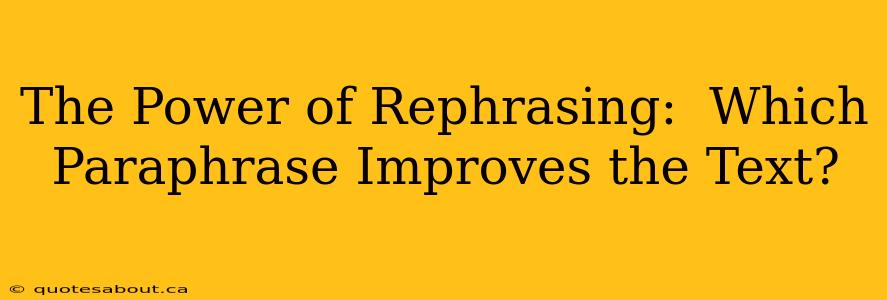Rephrasing, or paraphrasing, is a crucial skill for effective communication and writing. It involves expressing the same idea in different words, maintaining the original meaning while improving clarity, style, or avoiding plagiarism. But choosing the best paraphrase isn't always straightforward. This article explores the nuances of selecting the superior paraphrase and provides strategies for effective rephrasing.
What Makes a Good Paraphrase?
A strong paraphrase isn't just about changing a few words; it requires a deep understanding of the original text and the ability to convey its essence accurately and effectively. Several key elements contribute to a successful paraphrase:
- Accuracy: The core meaning must remain unchanged. A good paraphrase doesn't distort or misrepresent the original information.
- Clarity: The rephrased text should be easier to understand than the original, especially if the original is unclear or awkwardly phrased.
- Conciseness: Avoid unnecessary words or phrases. A good paraphrase is more succinct and to the point.
- Style: The paraphrase should fit the overall tone and style of the surrounding text. It shouldn't sound jarring or out of place.
- Originality: The paraphrase should be distinct enough to avoid plagiarism. Simply rearranging words is not sufficient. It needs to demonstrate genuine understanding and reinterpretation.
How to Choose the Best Paraphrase: A Step-by-Step Approach
Let's say you're presented with several paraphrases of the same sentence. How do you decide which is best? Follow this process:
- Understand the Original: Thoroughly analyze the original sentence. What is the main idea? What are the key supporting points?
- Compare the Paraphrases: Read each paraphrase carefully, paying close attention to accuracy, clarity, and style.
- Check for Accuracy: Does each paraphrase accurately reflect the meaning of the original? Are there any omissions or distortions of the original meaning?
- Assess Clarity: Which paraphrase is the easiest to understand? Does it flow smoothly and logically?
- Evaluate Style and Tone: Does the paraphrase maintain the appropriate style and tone of the original text? Does it fit the context in which it will be used?
- Consider Conciseness: Which paraphrase is the most succinct without sacrificing meaning?
- Identify Plagiarism Risks: Does any paraphrase closely resemble the original wording, potentially raising plagiarism concerns?
Common Mistakes to Avoid When Rephrasing
- Simply changing synonyms: Replacing individual words with synonyms without altering the sentence structure can still be considered plagiarism.
- Ignoring context: A paraphrase must make sense within the broader context of the surrounding text.
- Oversimplifying: Stripping away crucial details to make the text easier to understand can distort the original meaning.
- Adding your own opinions: A paraphrase should only reflect the original author's ideas, not your own interpretations.
Examples of Effective and Ineffective Paraphrases
Let's analyze a few examples to illustrate the points above.
Original Sentence: "The rapid advancement of technology has significantly impacted global communication."
Paraphrase 1 (Ineffective): "Technology's fast growth has really changed how the world talks." (Too informal and lacks precision)
Paraphrase 2 (Effective): "Global communication has undergone a dramatic transformation due to the rapid pace of technological progress." (Accurate, clear, and maintains a formal tone)
Frequently Asked Questions (FAQs)
How can I improve my paraphrasing skills?
Practice is key! Regularly rephrase sentences and paragraphs from different texts. Focus on understanding the core message before attempting to rewrite it. Use a thesaurus to expand your vocabulary and find alternative word choices.
Is it okay to use the same sentence structure when paraphrasing?
No, significantly altering the sentence structure is essential to demonstrate original thought and avoid plagiarism. Merely changing a few words while retaining the same structure is insufficient.
What are some tools that can help me paraphrase?
While paraphrasing tools can be helpful for generating ideas, always review and edit the output carefully to ensure accuracy, clarity, and originality. Over-reliance on these tools can hinder the development of crucial writing skills.
By understanding the principles of effective paraphrasing and applying these strategies, you can significantly improve your writing and communication skills. Remember, the goal isn't just to change words; it's to enhance understanding and convey meaning accurately and elegantly.

